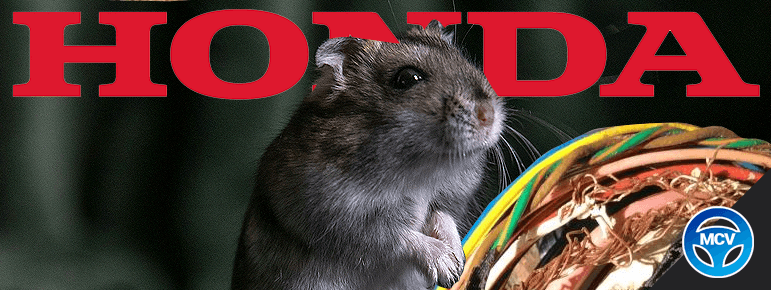In a recent lawsuit, American Honda Motor Co. Inc. found itself in the spotlight over allegations regarding their eco-friendly yet rodent-attracting wiring insulation.
While Honda’s soy-based wiring coating was a nod to sustainability, it unexpectedly lured in rodents, leading to costly damage for Chicago Honda owners.
The lawsuit Caracci v. American Honda Motor Co. Inc. in the Northern District of Illinois, a federal judge had to determine whether rats chewing on car wires coated with soy-based insulation constitutes a defect.
Automakers like Honda strive to embrace environmental consciousness. Yet the pressing question remains, at what expense does this come to the consumer?
Unlike traditional petroleum-based wire coatings, soy-based materials are derived from natural, plant-based sources. This makes them more appealing to rodents as a food source.
And with Chicago’s burgeoning rat population, I suspect that this won’t be the final lawsuit concerning these critters’ peculiar penchant for chewing through soy-based wiring coatings.
Let’s explore the complexities of this legal battle, and the relentless nature of Chicago’s rodent residents.
The Complaint Against Honda: Soy Based Wiring in Cars
At the center of this legal battle were allegations against American Honda Motor Co. Inc. The plaintiffs accused the automaker of using an insulation for vehicle wires that, while environmentally friendly, attracted rodents.
This attraction is not merely a nuisance, but can lead to significant damage to vehicle components, especially the wiring.
When rodents chew through wires, they can cause electrical failures and malfunctions in vehicles, leading to costly repairs for owners.
Truth is, Honda chose a soy-based wiring coating because it’s good for the environment. But it seems some animals like it too, for different reasons. They think the soy smells like food.
It turns out, rodents chew on wires to sharpen their teeth. These curious little creatures find soy-coated wires even more tempting.
The lawsuit argued that this choice not only led to damage but also represented a significant oversight Honda failed to address or warn consumers about.
However, U.S. District Judge Elaine E. Bucklo dismissed these claims, stating that the attraction of rodents to the wires does not inherently constitute a defect.
The ruling underscored an important legal distinction: the difference between a design choice and what the law considers a defect.
A City Under Siege by Rodents
Chicago’s longstanding battle with its rat population is critical to understanding the frustrations of the plaintiffs in the case.
Dubbed the “Rattiest City in America” for nearly a decade, the city’s rodent problem is a daily reality for its inhabitants.
In fact, a recent Orkin survey found Chicago as the nation’s most rodent-infested cities. And this dubious distinction has been given to Chicago for nine years in a row!
The decision to mention this context within the judicial opinion highlights the ubiquity of the issue. Not to mention underscores a critical gap in the argument presented against Honda.
The Legal Argument Against Soy-Based Wiring
Truth is, this isn’t the first time automotive companies have faced legal action over the use of soy-based wiring.
Previous lawsuits against manufacturers like Toyota and Kia echo similar grievances lodged against Honda.
Yet, the dismissal of these cases, including a notable decision by the Ninth Circuit, illustrates a challenging hurdle for plaintiffs.
Proving that soy-based coatings directly contribute to rodent-related damage in a way that constitutes a legal defect.
The Shift to Eco-Friendly Materials
The automotive industry’s move towards using soy-based and other bio-based materials is part of a larger trend towards sustainability.
These materials are chosen for their reduced environmental impact. Particularly in terms of their production processes and their ability to biodegrade more easily than synthetic alternatives.
The use of renewable materials also helps auto manufacturers reduce their dependence on oil. This results in the lowering of the carbon footprint of their vehicles. This is a win-win for both the environment and auto manufacturers.
However, the unintended consequence of making vehicles more attractive to rodents has been a significant challenge. The issue has not only led to class-action lawsuits, but has also prompted a wider discussion. A discussion about how to balance environmental goals with practicality and consumer safety.
The Unintended Consequences of Environmental Friendly Vehicle Components
Fact is, Honda’s shift to soy-based wire insulation was driven by environmental considerations. Honda, like so many other automakers, are both encouraged and expected to use of biodegradable materials.
Soy-based wiring is a conscious choice made by Honda to minimize environmental impact of it’s vehicles.
However, this case raises questions about the unforeseen consequences of such decisions. Particularly in urban environments where factors like rodent populations can introduce unexpected damage.
Auto Manufacturers’ Response
In response to these challenges, auto manufacturers have been exploring several strategies. Some companies have developed rodent deterrent tapes, wraps, or sprays that can be applied to components susceptible to rodent damage.
These deterrents often contain capsaicin, the compound that makes chili peppers hot. Harmless to the vehicle and its operation, it is repulsive to rodents.
Research and development efforts for new materials that can meet both environmental standards and reduce the attraction to rodents continues.
The Broader Implications of Soy-Based Components
Beyond the immediate legal outcome, this case prompts a broader discussion. One about the balance between environmental initiatives and the realities of their implementation.
Truth is, the automotive industry is constantly researching and developing new materials to increase the sustainability of their products.
In fact, the industry is exploring more sophisticated bio-based compounds. Compounds that retain the environmental benefits of soy-based materials, but without serving as a food source for pests.
Cities worldwide are grappling with similar rodent issues, making the implications of soy-based coatings extend beyond the confines of Chicago.
Looking Ahead
The court’s decision no doubt has been a setback for the plaintiffs. However, it opens the door for deeper examination of how companies communicate with consumers about the materials used in their products.
Especially as cities continue to confront the challenges posed by their non-human inhabitants.
Final Thoughts: Caracci v. American Honda Motor Co. Inc.
The case of Caracci v. American Honda Motor Co. Inc. may have concluded in the courtroom, but the conversation it sparked is far from over.
The case of rodents being attracted to soy-based wire insulation highlights a critical lesson for the auto industry. Sustainability efforts must consider the broader ecosystem in which vehicles exist.
As manufacturers continue to push towards more sustainable vehicles, lessons learned from these lawsuits will help shape future material choices.

Managing Editor
Christopher is an automotive technical writer. When he’s not at the local autocross event, he can often be found working on one of his cars. Specializes in automotive class action law, industry trends, and automotive maintenance. Email me direct, or learn more about us

